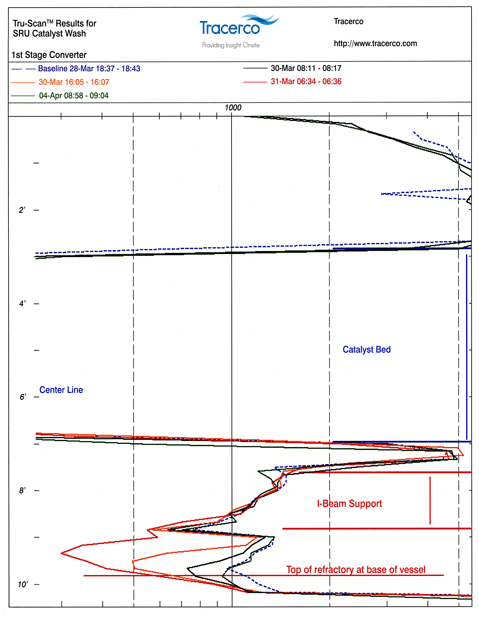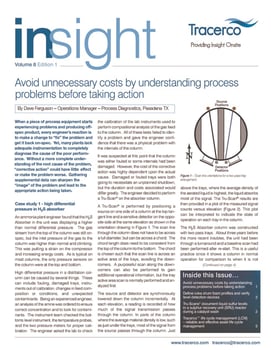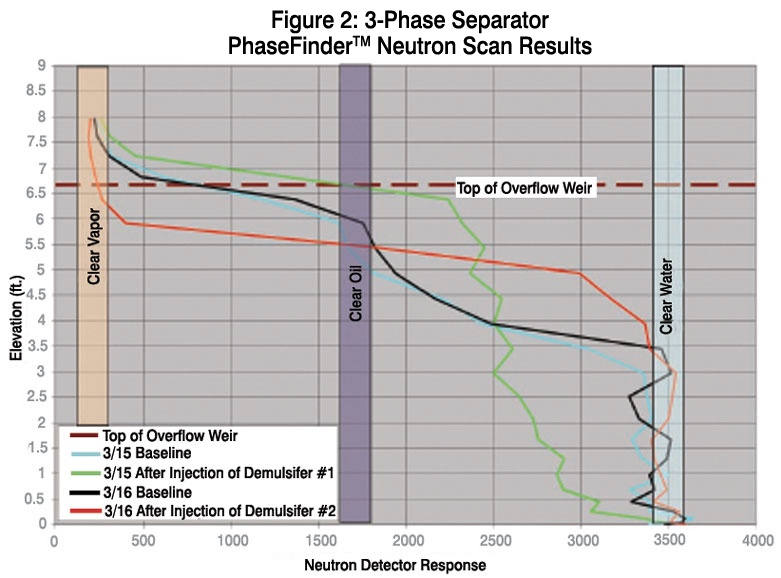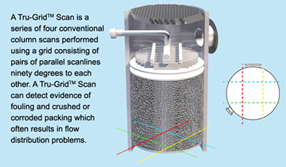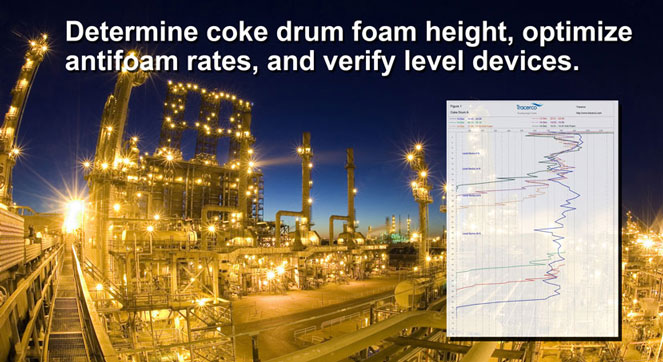Are you planning to “wash” a catalyst bed in a reactor and need to monitor process conditions?
Using Tru-Scan™ technology to detect liquid levels in pressure vessels and catalyst levels in reactors is a fast and extremely reliable measurement performed online. One of the problems operations staff faced when planning a catalyst “wash” was not having an indication of any accumulated liquid level in the bottom of the vessel to monitor the procedure. Read more on how Tracerco was able to assist a customer with monitoring the liquid level throughout their planned wash campaign.
Read More
Topics:
Tru-Scan,
gamma scan,
liquid restriction,
SRU Unit,
coke,
Sulphur Recovery Unit,
catalyst bed wash
The first issue of 2018's Tracerco Insight newsletter is now available.
Tracerco would like to wish you a Happy New Year. We are very much looking forward to celebrating our 60th anniversary in 2018.
To start the new year we have published the first issue of the Tracerco Insight newsletter featuring a few of our latest case studies illustrating how Tracerco was able to provide our customers the necessary data that allowed the operations staff to make informed decisions for troubleshooting and optimising their process.
Read More
Topics:
nucleonic instrumentation,
Tru-Scan,
gamma scan,
coke drum cycle,
coke drum optimization,
delayed coke drum,
feed/effluent heat exchangers,
tracer technology,
H2S Absorber,
Life cycle management,
Tracer Study,
SRU Unit,
coke,
Sulphur Recovery Unit,
catalyst bed wash,
Ammonia converter
Scans aid plant personnel in determining which demulsifier is best suited for their application.
Tracerco’s scanning technology is an excellent means of measuring interface levels, whether between vapour and liquids, liquid and solids, or between two different types of liquids. Tru-Scan™ and PhaseFinder™ neutron scanning technologies can be used very effectively in trials of emulsion breaking chemicals to determine the best type and concentration to use in a particular vessel. This can lead to increased efficiency and significant cost savings as well as reduce the environmental impact of excess chemical use.
This blog will present two demulsifier trials that will show the difference in performance base on the presence or absence of an emulsion layer.
Read More
Topics:
neutron backscatter,
Tru-Scan,
gamma scan,
Separator,
PhaseFinder,
Demulsifier Chemical,
interface levels
Tru-Scan™ results assist with diagnosing problems even in a challenging process such as liquid-liquid extractors.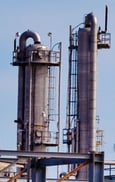
One category of special applications is liquid-liquid extractors. Besides the fact that liquid-liquid extractors are not “typical” distillation or fractionation unit operations, what makes them a special application for Tru-Scans™? The source and detector system that is used in scanning measures density changes of the process materials inside the tower. With a typical fractionation tower there is a large density difference between the vapour and liquid phases. Thus there is a large density range between clear vapour and clear liquid to detect process or operating conditions existing in a typical fractionation tower – entrainment, foaming, flooding, internal damage, etc. But liquid-liquid extractors are liquid full, with no large vapour-liquid density difference. Meaningful scan results from a liquid-liquid tower rely on the density difference between the two liquid phases being significant enough to distinguish as some extraction processes involve two liquids that have comparable densities.
So what will a Tracerco Tru-Scan™ of a liquid-liquid extractor tower show?
Since we do not have the large vapour-liquid density difference to work with, the information learned from a scan of a liquid-liquid extractor is less extensive than for a “typical” fractionation tower but not any less important. As the following examples show, scans of liquid-liquid extractors can detect problems when the two liquid phases are not properly mixing, preventing the tower from doing its proper extraction operation.
Read More
Topics:
gamma scan,
liquid liquid extractor,
extraction tower,
trayed extraction tower,
liquid restriction
On a regular basis customers see evidence suggesting the presence of a leak; such as a drop in process efficiency or the presence of a contaminant in product. This raises the question of where in the plant the leak is occurring or is the off-spec material do to some other problem.
In this latest blog, Tracerco, part of Johnson Matthey Plc, discusses how chemical tracers allowed the customer to replace a leaking exchanger bundle and restart the unit with minimal downtime.
Read More
Topics:
gamma scan,
off spec product,
online leak detection,
chemical leak test,
feed/effluent heat exchangers,
exchanger bundle leak testing
The crude unit of today’s modern refinery is where it all starts. Good, clean fractionation from the crude atmospheric and crude vacuum towers greatly impacts the operation of downstream units.
The wash bed in the Crude vacuum tower is one of those so-called evil necessities. When it operates well, it does not seem to garner much attention but, when things go wrong challenges can occur. The wash bed of the Crude vacuum tower is prone to coking/fouling due to the low liquid rates along with high vapour rates and high temperatures. Generally, the wetting rate at the top of the wash bed is minimised to prevent high-value product loss, but lower wetting rates lead directly to coke formation in the bed. The operating condition or the rate and severity of coking in the Crude vacuum tower wash bed is also one of the key variables determining the cycle time or run length between turnarounds. So, the typical refiner works to balance the economics of product Heavy Vacuum Gas Oil (HVGO) recovery versus unscheduled or premature downtime to replace a coked bed.
Marathon Petroleum Company LP’s (MPC) approach for operation of the vacuum tower wash bed is based on a novel approach. MPC regards the packing in the wash bed as a consumable item. The goal – fully consume the useful life of the packing by the end of the operating cycle to maximise operating profit, by maximising HVGO yield. MPC uses Tracerco’s ThruVision™ technology to routinely monitor the wash bed density to help manage the wash bed useful life during the operating cycle. The ThruVision™ technology provides a detailed density map at a specific vertical elevation that can pinpoint specific areas of liquid maldistribution or solids/liquid build-up.
This case study shows the learning process over short operating cycles and an example of the operating stratagem to manage the operating life of the vacuum column wash bed over a multi-year operating cycle.
CLICK HERE To download the full article that was published in the April 2017 issue of Hydrocarbon Engineering.
Read More
Topics:
Gamma Scanning,
Tru-Grid Scan,
ThruVision scan,
gamma scan,
liquid distribution,
quantitative analysis pack beds,
PackView Analysis,
monitor wash bed coking,
tomography scan
Tru-Grid™ Scans reveal vital process information that helps solve operating problems.
A Tru-Grid™ Scan of packed towers is a reliable and widely used field measurement used for evaluating the hydraulic performance in packed beds, including the results from plugging / fouling or damage. When experiencing problems there are two important questions you would like answered:
1. Where is the fouling / plugging or damage?
2. What is the extent of the hydraulic problem due to fouling or damage to the packing?
Gamma scanning has proven to be an essential measurement tool to supplement operating history data analysis. Process engineers and operations personnel need to know what is happening inside their process equipment so they can take corrective action. A Tru-Grid™ Scan provides a density profile of the internal process to diagnose hydraulic operating conditions such as damage to internals, flooding, liquid levels on trays and distributors, and liquid distribution through packed beds.
Performing Tru-Grid™ Scans before a scheduled shutdown can help capture real-time data to optimize your turnaround and reduce cost over-runs. Scan results will prepare those planning the turnaround activities with the knowledge needed for critical path decisions. Scans performed five to six weeks prior to a scheduled shutdown usually provides enough time to order new equipment without expediting charges and to schedule the required manpower.
In this latest blog, Tracerco, part of Johnson Matthey Plc, discusses how an unexpected pressure surge affected the performance of an acid solvent recovery column.
Read More
Topics:
Gamma Scanning,
Tru-Grid Scan,
gamma scan,
packing mal-distribution,
liquid distribution,
quantitative analysis pack beds,
PackView Analysis,
packed bed towers,
packed bed scan
Tracerco will be highlighting our latest technology and improved analysis, PackView™ for packed towers, at this year's AIChE 2017 Spring Meeting in San Antonio, Texas.
Topical 8 - Session: Kister Distillation Symposium 2017:
Distillation Troubleshooting and Controls: Lessons Learned
Tracerco Presentation Details:
"Packed Bed Performance Analytics Based on Gamma Scans"
Wednesday March 29, 2017 8:05 am
Room 302 AB, Henry B. Gonzalez Convention Center
Mark your schedule to sit in on the paper "Packed Bed Performance Analytics Based on Gamma Scans" presented by Lowell Pless - Business Development Manager - Distillation Applications for Johnson Matthey - Tracerco. The presentation will provide actual case studies illustrating how this advanced analysis provides a new method of extracting quantitative information from gamma scan data to diagnose and characterize operation of distillation and separation towers. Read more about the the presentation in the following abstract that will provide an overview of what will be presented.
Read More
Topics:
Gamma Scanning,
Tru-Grid Scan,
gamma scan,
packing mal-distribution,
liquid distribution,
quantitative analysis pack beds,
PackView Analysis
Tru-Scan™ is used by refineries to define foam profiles and verify level detection devices in their coke drums. A Tru-Scan™ can determine the difference in vapour density throughout a typical drum cycle.
In this latest blog, Tracerco, discusses how a Tru-Scan™ can be a powerful tool for gathering much needed information to optimise a coke drum cycle.
Read More
Topics:
Gamma Scanning,
Tru-Scan,
coke buildup,
coke deposits,
gamma scan,
level detection devices,
coke drum cycle,
coke drum optimization,
coke drum,
foam profile,
coker optimization,
coker units,
delayed coke drum
